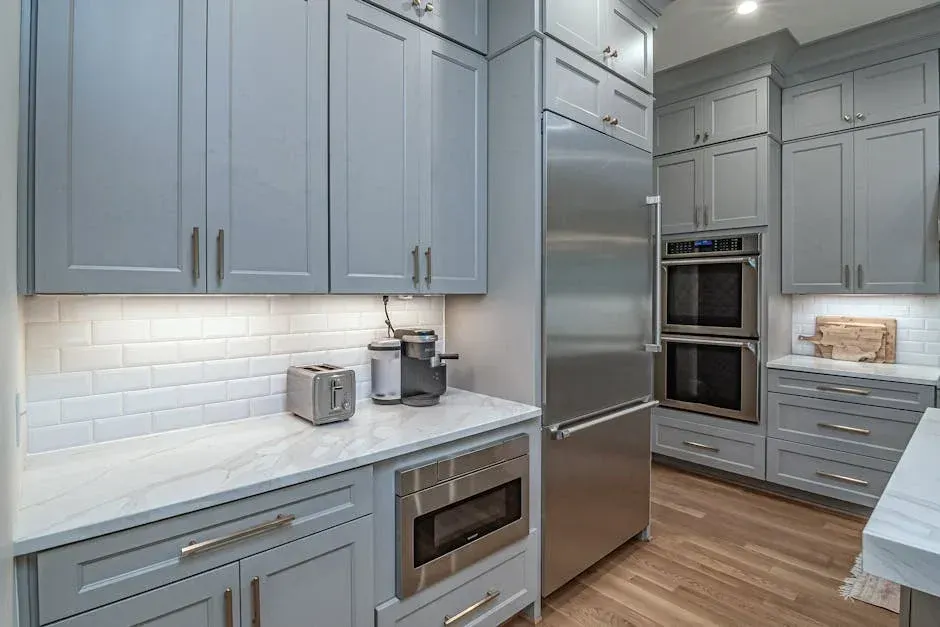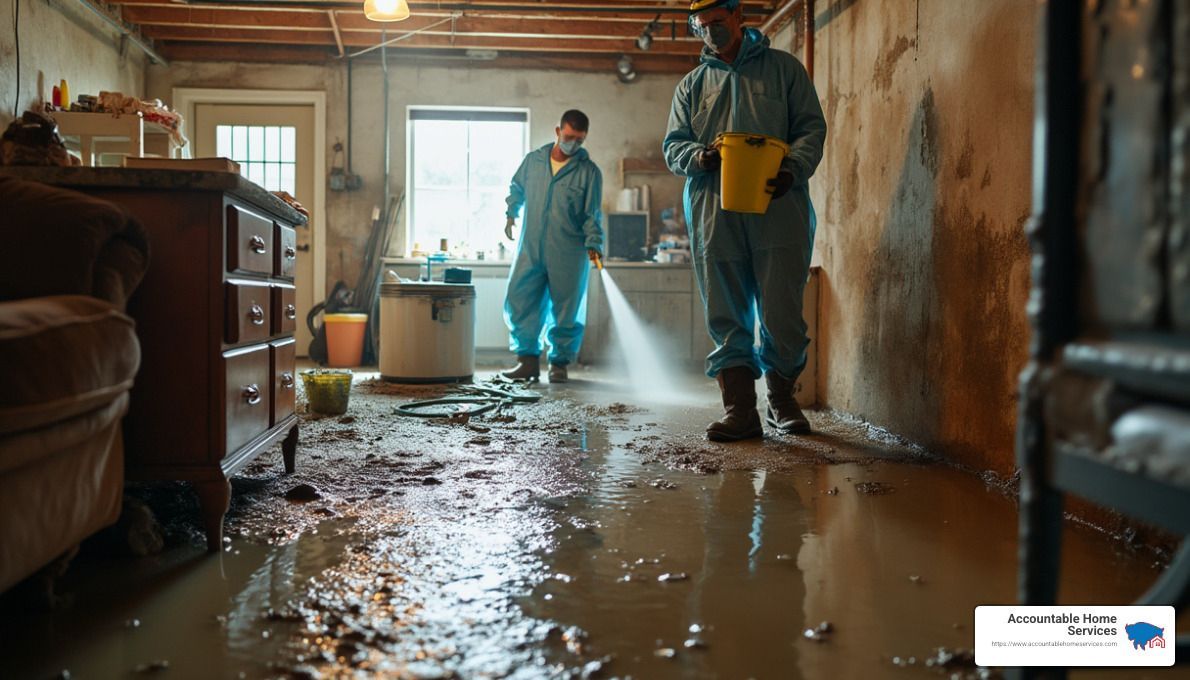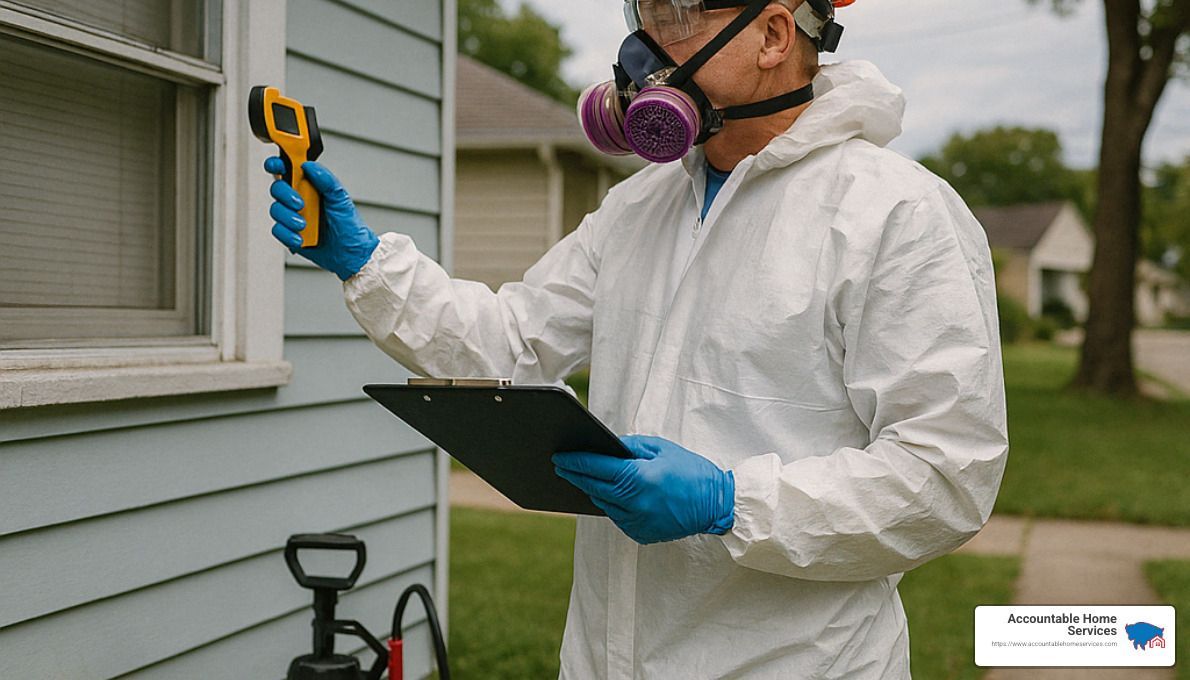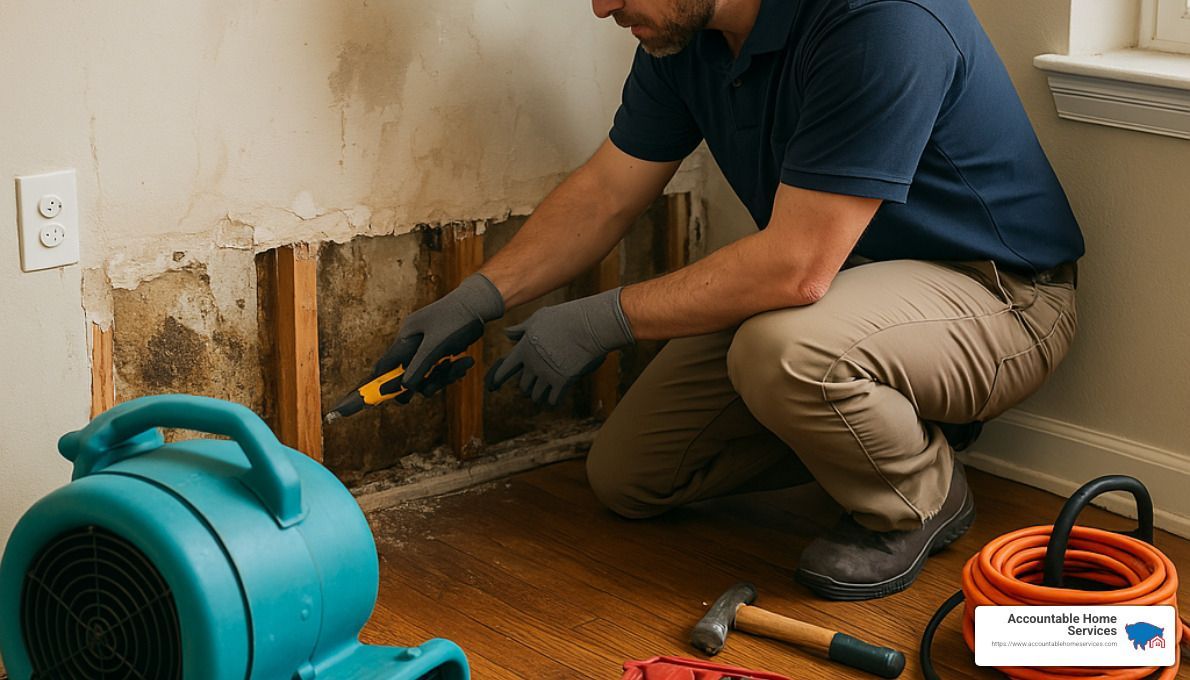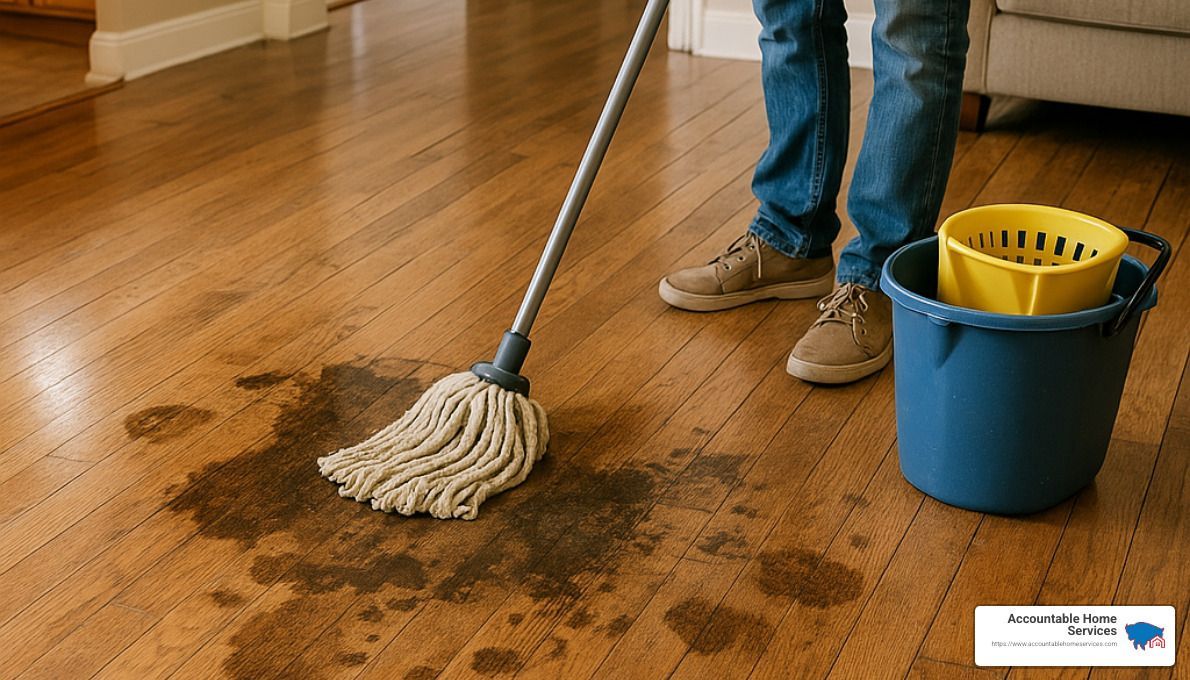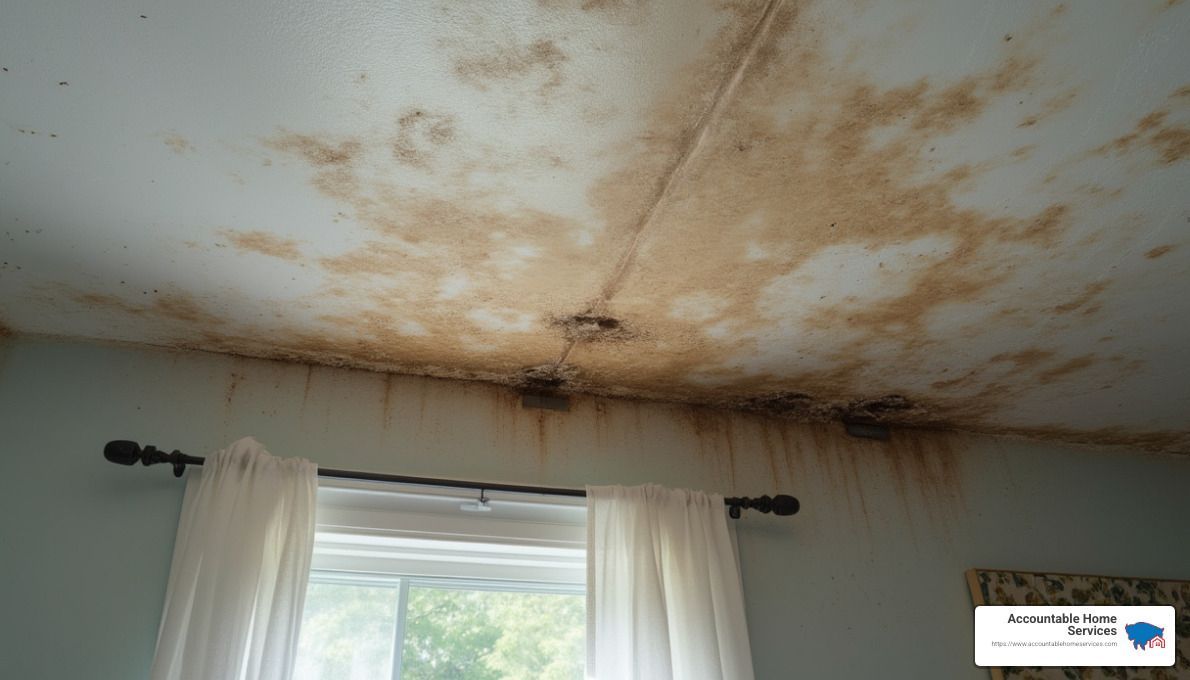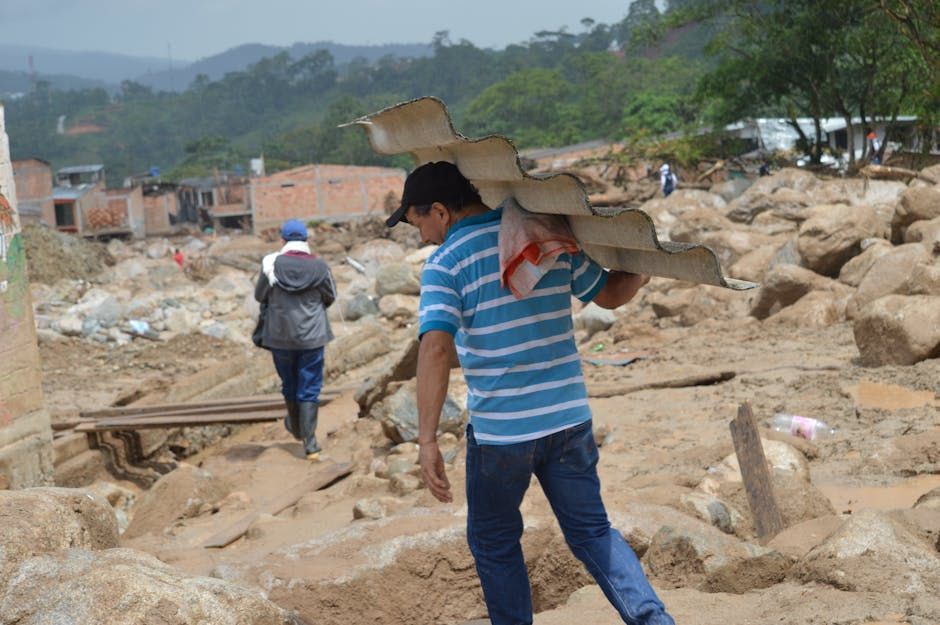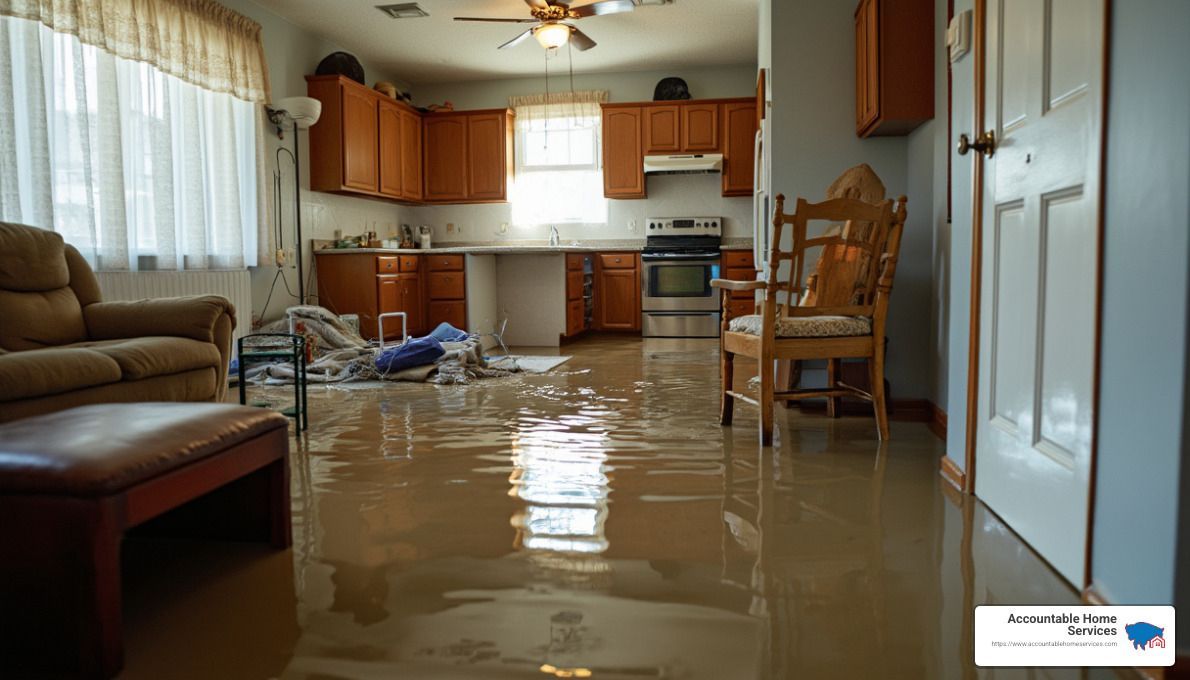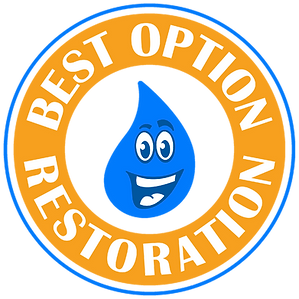Blog
When dealing with water damage, it can feel overwhelming, but water damage restoration services are here to help. Whether it's from a burst pipe, plumbing failures, or unexpected accidents, professional water damage restoration services can quickly and effectively restore your home.
Here's what to do if water damage occurs:
- Stop the source: (if possible) Immediately halt the water to prevent further damage.
- Contact professionals: Call a certified water damage restoration service immediately.
- Document the damage: Take photographs and notes of the affected areas for insurance purposes.
- Begin the restoration: With expertise in assessing, drying, sanitizing, and repairing, professionals will guide you step-by-step.
I'm Mike Martinez, and as the proud owner of Accountable Home Services, I've spent years specializing in water damage restoration. Our customer-first philosophy and industry certifications ensure you're in qualified hands.
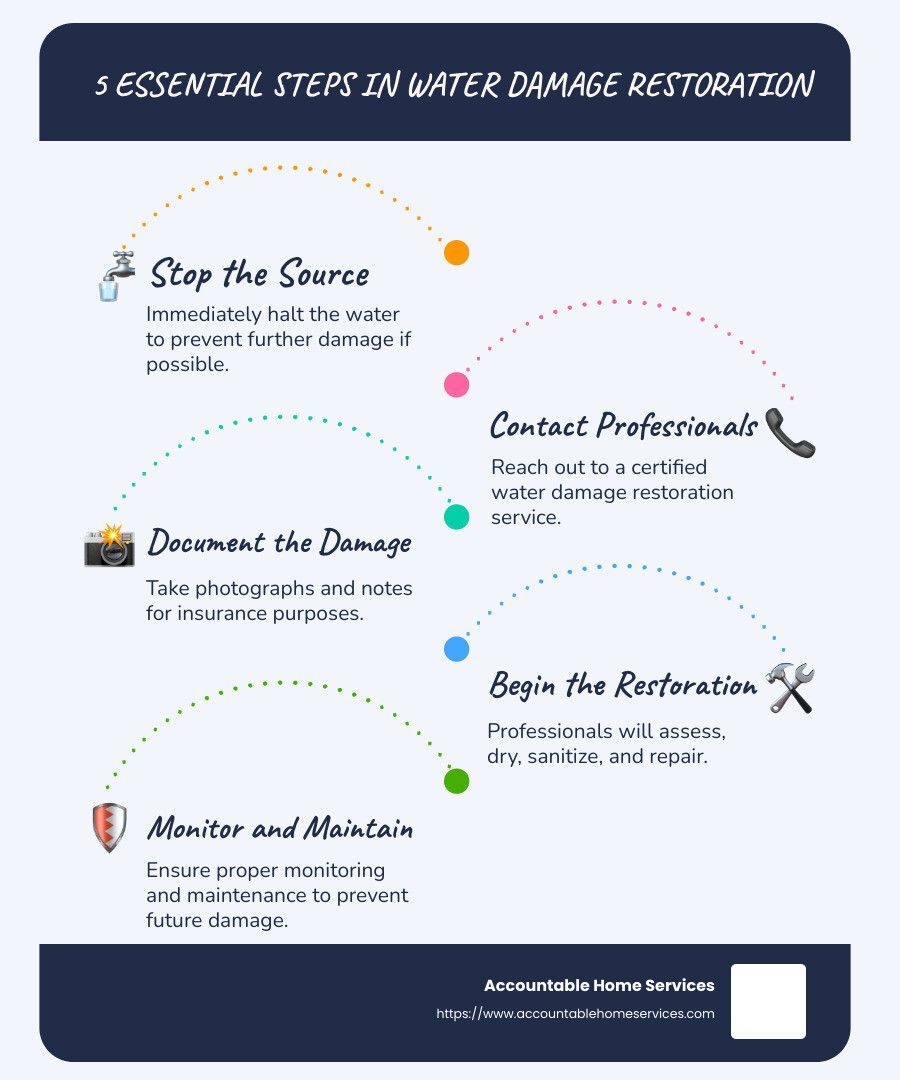
Step 1: Assess the Damage
Before diving into the restoration process, the first crucial step is to assess the damage. This involves a thorough inspection to understand the extent and severity of the water damage.
Inspection
Start with a visual inspection of all affected areas. Look for visible signs such as water stains, discoloration on walls and ceilings, or warped flooring. These indicators can give you an initial idea of where the damage is most severe.
Pro Tip: Use a flashlight to inspect dark areas like basements and attics. These spaces are often prone to hidden water damage.
Moisture Detection
Visual inspections are just the beginning. Water can seep into unseen areas, causing long-term problems like mold growth. Use moisture detectors or hygrometers to measure the moisture levels in walls, floors, and ceilings. These tools help identify areas that may not appear wet but are retaining moisture.
It’s vital to address these hidden areas to prevent future issues and ensure a complete restoration.
Safety Hazards
Water damage can create several safety hazards. Be cautious of:
- Electrical risks: Water and electricity are a dangerous combination. If water has reached electrical outlets or appliances, turn off the power supply to prevent shocks or fires.
- Structural damage: Water can weaken structures, making floors or ceilings unstable. Avoid walking on or under visibly compromised areas.
- Health risks: Standing water can harbor bacteria and mold. Protect yourself with gloves and masks if you need to enter these areas.
By carefully assessing these factors, you can develop a comprehensive plan for water damage restoration and ensure that all safety precautions are in place.
Once you have a clear understanding of the damage, you can proceed to the next step: removing water and drying the area. This is where professional equipment and expertise come into play, ensuring a thorough and efficient restoration process.
Step 2: Remove Water and Dry the Area
Once you've assessed the damage, the next critical step in water damage restoration is to remove the water and dry the affected area. This process is essential to prevent further damage and inhibit mold growth.
Water Extraction
Start by removing all standing water. This can be done using various tools, depending on the severity of the situation. For small puddles, mops and buckets may suffice. For larger volumes, consider using:
- Wet/dry vacuums: These are suitable for minor flooding and can handle small to medium amounts of water.
- Submersible pumps: Ideal for significant flooding, these pumps can quickly remove large volumes of water.
Pro Tip: Act fast to remove water within 24-48 hours to minimize damage and reduce the risk of mold growth.
Drying Equipment
After water extraction, the next step is to dry the area thoroughly. This requires specialized equipment to ensure all moisture is eliminate
- Air movers: These high-velocity fans help increase airflow across surfaces, speeding up the drying process.
- Dehumidifiers: Essential for reducing humidity levels, dehumidifiers work by pulling moisture from the air, which helps to dry out damp areas.
Dehumidifiers
Dehumidifiers are a crucial component in the drying process. They help prevent mold and mildew by maintaining low humidity levels. There are different types of dehumidifiers:
- Refrigerant dehumidifiers: These are effective for most residential scenarios, operating by cooling the air to remove moisture.
- Desiccant dehumidifiers: Typically used in colder environments or when drying dense materials, these dehumidifiers use chemicals to absorb moisture.
Pro Tip: Position dehumidifiers in the center of the room for maximum efficiency, and keep doors and windows closed to prevent additional moisture from entering.
By using the right equipment and techniques, you can effectively remove water and dry the area, setting the stage for the next steps in the restoration process. This ensures your home is safe, dry, and ready for any necessary repairs or renovations.
Step 3: Clean and Sanitize
Once the water is removed and the area is dry, it's time to clean and sanitize to prevent mold and ensure a safe environment. This step is crucial in water damage restoration to eliminate contaminants and avoid health risks.
Mold Prevention
Mold can start growing within 24 to 48 hours after water damage. To prevent this, act quickly and efficiently:
- Inspect for Mold: Look for visible signs of mold, especially in hidden areas like behind walls or under flooring.
- Use Mold Inhibitors: Apply mold inhibitors to surfaces as a precautionary measure. These products can be found in most hardware stores and are easy to use.
Pro Tip: Regularly monitor moisture-prone areas to catch mold early and address issues promptly.
Disinfectants
Disinfection is vital to eliminate bacteria and other pathogens that may have come in with the water. Here’s how to go about it:
- Select the Right Disinfectant: Use EPA-approved disinfectants that are effective against bacteria, viruses, and fungi.
- Follow Instructions: Always follow the manufacturer's instructions for dilution and application to ensure effectiveness.
Pro Tip: Wear protective gear like gloves and masks when applying disinfectants to avoid skin irritation or inhalation of fumes.
Cleaning Techniques
Proper cleaning techniques can make a significant difference in restoring your home to a safe and habitable state:
- Surface Cleaning: Start with non-porous surfaces, wiping them down with a disinfectant solution. For porous materials like carpets or upholstery, professional cleaning might be necessary.
- Air Quality: Consider using air purifiers to improve indoor air quality and remove any lingering odors or airborne contaminants.
Pro Tip: Pay special attention to areas that had prolonged exposure to water, as these are more susceptible to bacteria and mold growth.
By focusing on mold prevention, using effective disinfectants, and employing proper cleaning techniques, you can ensure that your home is not only restored but also safe and healthy for reoccupation. This sets the foundation for the next step, which involves repair and restoration to bring your home back to its original condition.
Step 4: Repair and Restore
After cleaning and sanitizing, it's time to repair and restore your home to its original condition. This step involves fixing structural damage, replacing materials, and possibly undertaking renovations.
Structural Repairs
Structural repairs are crucial to ensure your home is safe and sound. Here's what to focus on:
- Assess Structural Integrity: Check for damage to load-bearing walls, beams, and the foundation. These elements are critical for the stability of your home.
- Hire Professionals: For major repairs, it's wise to bring in structural engineers or contractors with experience in water damage restoration. They can accurately assess and repair any issues.
Pro Tip: Address structural issues promptly to prevent further deterioration and ensure your home's safety.
Material Replacement
Water damage often necessitates material replacement, especially for porous materials that can't be salvaged:
- Flooring: Carpets, hardwood floors, and laminates may need replacement if they've absorbed too much water. Consider water-resistant options for future protection.
- Drywall and Insulation: These materials can harbor mold and should be replaced if severely damaged. Use moisture-resistant drywall in areas prone to water exposure.
Pro Tip: When replacing materials, choose those that offer better resistance to water damage to future-proof your home.
Renovation
Sometimes, water damage presents an opportunity for renovation. You might consider updating or improving your space during the restoration process:
- Redesign Affected Areas: Use this chance to redesign or upgrade parts of your home, like the kitchen or bathroom, with modern, water-resistant materials.
- Energy Efficiency: Incorporate energy-efficient fixtures and appliances. This not only improves your home's functionality but can also reduce future utility bills.
Pro Tip: Plan renovations with long-term resilience in mind, incorporating solutions that minimize future water damage risks.
By focusing on structural repairs, replacing damaged materials, and considering renovations, you can restore your home to a better state than before. This comprehensive approach ensures longevity and resilience against future water damage.
Step 5: Prevent Future Water Damage
Preventing future water damage is essential to protect your home and avoid costly repairs. Here are some key strategies to help you safeguard your property:
Waterproofing
Waterproofing is your first line of defense against water damage. It involves making surfaces and structures resistant to water penetration. Consider these options:
- Basement Waterproofing: Seal walls and floors with waterproof coatings to prevent seepage. This is especially important in older homes with porous foundations.
- Roof Sealing: Apply protective sealants to your roof to prevent leaks. Regularly inspect and maintain roofing materials to ensure they remain intact.
Pro Tip: Regularly inspect waterproofed areas for signs of wear and reapply sealants as needed to maintain their effectiveness.
Drainage Systems
Effective drainage systems are crucial for directing water away from your home. Here's how to optimize your setup:
- Gutters and Downspouts: Ensure gutters are clean and downspouts extend at least six feet away from your foundation. This prevents water from pooling and infiltrating your home.
- French Drains: Install French drains around your property to channel water away from critical areas. These systems are especially useful in areas with heavy rainfall or poor natural drainage.
Pro Tip: Regularly check drainage systems for blockages and ensure they're functioning properly, especially after storms.
Maintenance Tips
Regular maintenance can prevent minor issues from becoming major problems. Follow these tips to keep your home safe from water damage:
- Inspect Regularly: Check for leaks under sinks, around windows, and in the basement. Early detection can prevent extensive damage.
- Maintain Appliances: Regularly service water heaters, washing machines, and dishwashers. Replace hoses and parts as needed to prevent leaks.
- Climate Control: Use dehumidifiers in damp areas like basements to reduce moisture levels, which can prevent mold growth.
Pro Tip: Create a maintenance schedule to ensure regular checks and upkeep, keeping your home in optimal condition.
By implementing these preventive measures, you can significantly reduce the risk of water damage and maintain the integrity of your home. Taking proactive steps today will save you time and money in the future.
Frequently Asked Questions about Water Damage Restoration
What are the signs of water damage?
Spotting water damage early can save you from costly repairs. Here are some common signs to watch for:
- Stains and Discoloration: Look for yellowish or brown spots on ceilings and walls. These often indicate water infiltration.
- Peeling Paint or Wallpaper: Moisture can cause paint and wallpaper to bubble or peel away from the walls.
- Musty Odors: A persistent musty smell might suggest mold growth, which thrives in damp conditions.
- Warped Floors: Hardwood floors may start to buckle or warp if they've absorbed water.
- Mold Growth: Visible mold, especially in corners or hidden areas, is a clear indicator of water presence.
Quick Tip: Regularly inspect your home for these signs, especially after heavy rains or plumbing issues.
How long does water damage restoration take?
The timeline for water damage restoration varies based on several factors:
- Extent of Damage: Minor water damage might be resolved in a few days, while extensive damage could take weeks.
- Type of Water: Clean water damage is quicker to address than damage involving contaminated or sewage water.
- Restoration Steps: The process includes drying, cleaning, repairing, and possibly remodeling, each adding time.
Typically, the drying process alone can take 3-5 days, depending on moisture levels and humidity. Full restoration, including repairs, might take anywhere from a week to several weeks.
Quick Tip: Work with a professional restoration service to get an accurate timeline based on your specific situation.
Is water damage covered by insurance?
Whether water damage is covered by insurance depends on your policy and the cause of the damage:
- Sudden and Accidental Damage: Most homeowners insurance policies cover unexpected events like burst pipes or appliance failures.
- Negligence or Poor Maintenance: Damage due to neglect, such as ignored leaks, is typically not covered.
- Flood Damage: Standard policies usually do not cover natural flooding. A separate flood insurance policy is needed.
- Sewer Backups: Coverage for sewer backups often requires an additional policy rider.
Quick Tip: Review your insurance policy details and speak with your provider to understand your coverage. Knowing what is covered can help you make informed decisions during an emergency.
By understanding these aspects of water damage restoration, you can better prepare for potential issues and steer the restoration process with confidence.
Conclusion
When it comes to water damage restoration in the Denver Metro Area, Accountable Home Services stands ready to assist you. Our family-owned business is dedicated to restoring your home quickly and efficiently, minimizing stress and disruption in your life. We know that dealing with water damage can be overwhelming, which is why we offer 24/7 emergency response.
Our certified technicians use state-of-the-art equipment to ensure your home is not just restored, but also protected against future damage. Whether you're dealing with a sudden pipe burst or the aftermath of a heavy storm, we are here to help. We handle everything from water extraction to complete home renovation, providing a seamless service that includes direct insurance billing.
Our focus on transparent communication and top-quality craftsmanship makes us a trusted partner in the community. We understand Colorado's unique climate challenges and tailor our solutions to meet your specific needs, ensuring your home stays safe and sound.
Quick action is crucial in water damage situations. If you suspect any issues, don't hesitate to reach out to us. We're just a call away, ready to provide the expert care your home deserves. Trust Accountable Home Services to be your reliable partner in water damage restoration.

